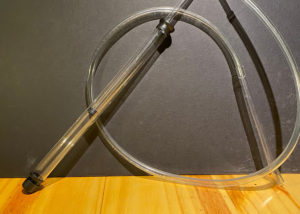WHAT IS AN AIRLOCK?
An airlock is a small device used in the process of fermenting mead (or other fermented beverages) to allow gases to escape while preventing outside air from entering the container. Essentially, an airlock is a valve that allows carbon dioxide (CO2) to escape from the container, while also preventing oxygen (O2) from entering.
During the process of fermenting mead, yeast consumes the sugars in the honey and produces alcohol and CO2 as byproducts. This process creates pressure inside the container, which needs to be released to prevent the container from exploding. At the same time, it’s important to keep the mead free from contamination by outside bacteria and other microorganisms, which could spoil the batch.
That’s where the airlock comes in. The airlock is typically inserted into a hole in the top of the fermentation vessel (such as a carboy or a fermenting bucket), and filled with water or another sterilizing solution. As the CO2 escapes from the container during fermentation, it bubbles through the liquid in the airlock, creating a barrier that prevents any outside air (and potential contaminants) from entering the container.
In summary, the purpose of an airlock in mead-making (and other fermentation processes) is to allow for the release of gases while also preventing contamination from outside sources. It’s a simple but essential device that helps ensure the success of a batch of mead.
– Content on this site was created by or with the help of the ChatGPT and the OpenAI project.
This site is a participant in the Amazon Services LLC Associates Program and As an Amazon Associate may earn from qualifying purchases.









